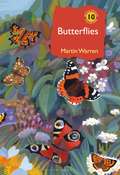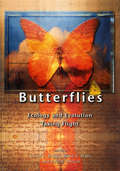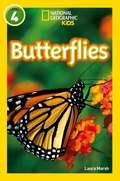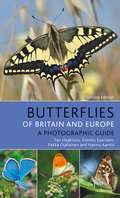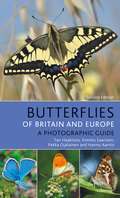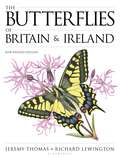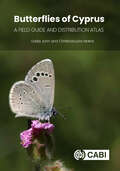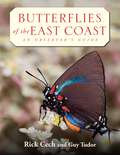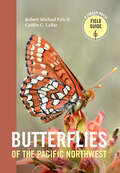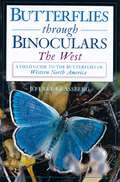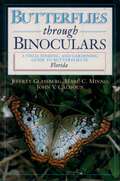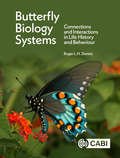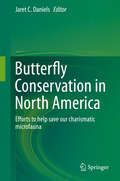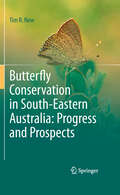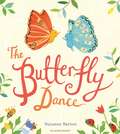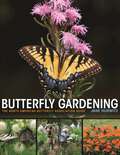- Table View
- List View
Butterflies: A Natural History (British Wildlife Collection)
by Martin WarrenThis new addition to the British Wildlife Collection is a unique take on butterfly behaviour and ecology, written by the former Chief Executive of Butterfly Conservation, Martin Warren. It explores the secret lives of our British species (also drawing on comparative examples from continental Europe), revealing how they have become adapted to survive in such a highly competitive natural world. Combining personal anecdote with the latest discoveries in the scientific literature, this book covers everything from why we love butterflies and their life-cycle from egg to adult, to their struggle for survival in a world of predators and parasites and the miracle of migration. The final chapters explore how butterflies are recorded, the change in their ranges and abundance during the 20th and 21st centuries, and the significance of managing habitats at a landscape scale, concluding with a passionate plea for why we must act now to reverse butterfly declines.Insightful, inspiring and a joy to read, Butterflies is the culmination of a lifetime of careful research into what makes these beautiful insects tick and how and why we must conserve them.
Butterflies: Ecology and Evolution Taking Flight
In Butterflies: Ecology and Evolution Taking Flight, the world's leading experts synthesize current knowledge of butterflies to show how the study of these fascinating creatures as model systems can lead to deeper understanding of ecological and evolutionary patterns and processes in general. The twenty-six chapters are organized into broad functional areas, covering the uses of butterflies in the study of behavior, ecology, genetics and evolution, systematics, and conservation biology. Especially in the context of the current biodiversity crisis, this book shows how results found with butterflies can help us understand large, rapid changes in the world we share with them—for example, geographic distributions of some butterflies have begun to shift in response to global warming, giving early evidence of climate change that scientists, politicians, and citizens alike should heed. The first international synthesis of butterfly biology in two decades, Butterflies: Ecology and Evolution Taking Flight offers students, scientists, and amateur naturalists a concise overview of the latest developments in the field. Furthermore, it articulates an exciting new perspective of the whole group of approximately 15,000 species of butterflies as a comprehensive model system for all the sciences concerned with biodiversity and its preservation. Contributors: Carol L. Boggs, Paul M. Brakefield, Adriana D. Briscoe, Dana L. Campbell, Elizabeth E. Crone, Mark Deering, Henri Descimon, Erika I. Deinert, Paul R. Ehrlich, John P. Fay, Richard ffrench-Constant, Sherri Fownes, Lawrence E. Gilbert, André Gilles, Ilkka Hanski, Jane K. Hill, Brian Huntley, Niklas Janz, Greg Kareofelas, Nusha Keyghobadi, P. Bernhard Koch, Claire Kremen, David C. Lees, Jean-François Martin, Antónia Monteiro, Paulo César Motta, Camille Parmesan, William D. Patterson, Naomi E. Pierce, Robert A. Raguso, Charles Lee Remington, Jens Roland, Ronald L. Rutowski, Cheryl B. Schultz, J. Mark Scriber, Arthur M. Shapiro, Michael C. Singer, Felix Sperling, Curtis Strobeck, Aram Stump, Chris D. Thomas, Richard VanBuskirk, Hans Van Dyck, Richard I. Vane-Wright, Ward B. Watt, Christer Wiklund, and Mark A. Willis
Butterflies: Level 4 (PDF)
by Laura Marsh National Geographic Kids StaffNational Geographic Primary Readers pair magnificent National Geographic photographs with engaging text by skilled authors to help your child learn to read. Developed by education experts, this series of books for beginner readers is spread across four levels: Early Reader, Becoming Fluent, Becoming Independent and Independent Reader. Did you know that the monarch butterfly – one of the most seemingly delicate of all of nature’s animals – is actually one of the toughest? Children can discover the fascinating story of these beautiful butterflies through stunning photographs and accessible text in this National Geographic Kids Level 4 Reader. Level 4: Independent Reader books are perfect for kids who are reading on their own with ease and are ready for more challenging vocabulary with varied sentence structures. They are ideal for readers of White and Lime book bands for guided reading.
Butterflies of Britain and Europe: A Photographic Guide
by Tari Haahtela Kimmo Saarinen Pekka Ojalainen Hannu AarnioPacked with beautiful photography and thoroughly updated throughout, this is the definitive guide to all 472 species of European butterflies with additional information on another 64 species found in North Africa and south and west Turkey. Detailed text and clear photographs – including views of both the upperwing and underwing where possible – allow identification of adult butterflies in the field. There is also useful information on their relative size, similar species, habitat, lifestyle and larval host plants, accompanied by accurate range maps which have been updated for this new edition. The result of collaboration between many European butterfly experts and photographers, and compiled by a Finnish team, this thoroughly updated and comprehensive guide represents the last word in butterfly identification.
Butterflies of Britain and Europe: A Photographic Guide
by Tari Haahtela Kimmo Saarinen Pekka Ojalainen Hannu AarnioPacked with beautiful photography and thoroughly updated throughout, this is the definitive guide to all 472 species of European butterflies with additional information on another 64 species found in North Africa and south and west Turkey. Detailed text and clear photographs – including views of both the upperwing and underwing where possible – allow identification of adult butterflies in the field. There is also useful information on their relative size, similar species, habitat, lifestyle and larval host plants, accompanied by accurate range maps which have been updated for this new edition. The result of collaboration between many European butterfly experts and photographers, and compiled by a Finnish team, this thoroughly updated and comprehensive guide represents the last word in butterfly identification.
Butterflies of Britain and Ireland
by Jeremy ThomasThe Butterflies of Britain & Ireland provides comprehensive coverage of all our resident and migratory butterflies, including the latest information on newly discovered species such as Cryptic Wood White and the Geranium Bronze. When first published in 1991 it won the Natural World Book of the Year Award and won plaudits from all quarters. Fully revised, considerably expanded and reset in 2010, it was judged that year's Guardian Nature Book of the Year. Now revised again to reflect the latest research findings, and with up-to-date distribution maps, this remarkable book is THE guide to the appearance, behaviour, life cycle and ecology of the butterflies of Britain and Ireland.
The Butterflies of Britain and Ireland
by Jeremy ThomasThe Butterflies of Britain & Ireland provides comprehensive coverage of all our resident and migratory butterflies, including the latest information on newly discovered species such as Cryptic Wood White and the Geranium Bronze. When first published in 1991 it won the Natural World Book of the Year Award and won plaudits from all quarters. Fully revised, considerably expanded and reset in 2010, it was judged that year's Guardian Nature Book of the Year. Now revised again to reflect the latest research findings, and with up-to-date distribution maps, this remarkable book is THE guide to the appearance, behaviour, life cycle and ecology of the butterflies of Britain and Ireland.
Butterflies of Cyprus: A Field Guide and Distribution Atlas
by Eddie John Christodoulos MakrisThis new book summarises decades of research and collation of distributional data. From the tiny Freyeria trochylus (Grass Jewel), Europe's smallest butterfly, to the magnificent, newly arrived Papilio demoleus (Lime Swallowtail), this comprehensively illustrated reference book and field guide includes all butterfly species known in Cyprus over the past 100 years. Where applicable, reference is made to subspecies of related taxa present in nearby countries of the eastern Mediterranean. The images on the cover represent the island's seven endemics, discussed in depth. Included, too, are detailed distribution maps representing records garnered from almost 300 recorders/sources (particularly members of the Cyprus Butterfly Study Group), over a period of more than 20 years.
Butterflies of the East Coast: An Observer's Guide
by Rick Cech Guy TudorHere is an accessible, informative, and highly illustrated book that offers a fresh view of butterflies in the East Coast states, from the Atlantic seaboard to the Appalachians. In addition to providing a wealth of facts and photos, the book is the first to furnish detailed and up-to-date photo-illustrated information on the host plants favored by particular species. With 234 full-page species accounts and accompanying range maps, plus more than 950 large-size color photos, it is an essential reference work for field observers, gardeners, educators, and conservation managers--or anyone interested in appreciating the lepidopteran world close at hand.The introductory chapters detail the subtle ecology of the East Coast region, establishing a consistent ecological framework that enriches the individual species accounts. There is also an overview of current scientific literature and observational findings to help readers better interpret complex butterfly behaviors in the field, including seasonal movements, host plant and diapause strategies, defensive chemistry, and more.The book is written by Rick Cech, a seasoned field observer who has spent years studying and photographing East Coast butterflies. His substantial first-hand experience with both the common and rare species in the region adds much depth and new insight to the commentary.234 full-page species accounts and accompanying range maps950 large-size color photos215 photos of individual host plants and habitats735 high-quality photos of butterflies and caterpillarsIntroductory chapters detailing the subtle ecology of the East Coast regionAn overview of current scientific literature and observational findingsDescriptions of diapause and host plant strategies and defensive chemistryUser-friendly with clear, concise text
Butterflies of the Pacific Northwest (A Timber Press Field Guide)
by Robert Michael Pyle Caitlin C. LaBarA comprehensive guide to the butterflies of the Pacific Northwest from the region&’s foremost butterfly experts.
Butterflies through Binoculars: The West (Butterflies Through Binoculars)
by Jeffrey GlassbergThis field guide offers a comprehensive display of all the magnificent butterflies of the western region, stretching from the plains of middle America to the Pacific coast, and from southwestern Canada all the way to the Hawaiian islands. Jeffrey Glassberg's acclaimed Butterflies Through Binoculars series has essentially revolutionized the way we view butterflies. Featuring an extensive array of photographs, this new volume offers expert guidance in locating, identifying, and enjoying all the butterflies of the West. In fact, together with its companion volume Butterflies Through Binoculars: The East, every type of butterfly from the continental United States is described and, in most cases, photographed. As a complement to its outstanding instruction in spotting both rare and common butterfly species, the volume also includes range maps, advice on food plants, wing areas, flight times, and a host of other butterfly facts. Moreover, each stunning photograph contains identification marks, shown clearly for ease in positive identification. From butterfly biology to butterfly conservation, this useful and practical field guide provides all the necessary information to make your butterfly experience a success. Whether you are a butterfly enthusiast, a birder, a conservationist, or a nature lover in general, this guide is the ideal accompaniment to your search for western butterflies.
Butterflies through Binoculars (Butterflies Through Binoculars)
by Jeffrey Glassberg Marc C. Minno John V. CalhounButterfly enthusiasts, nature lovers, and curious general readers will perhaps be surprised to learn that Florida's butterfly fauna is unique--and that, until the appearance of this volume, there has been no adequate field guide for the butterflies of this region. This guide simplifies identification by illustrating only species found in Florida--using superb photographs of live butterflies coupled with detailed range maps and identification data. It also offers, with unprecedented detail, much information on flight times and abundances for each of five Florida subregions, including reports on 70 localities in which to find butterflies. Lastly, discussions of the foodplants for each species along with suggestions for attracting these species to one's garden make this work invaluable for all Florida gardeners interested in butterflies.
Butterfly Biology Systems: Connections and Interactions in Life History and Behaviour
by Roger L DennisIn Butterfly Biology Systems Roger Dennis explores key topics and contentious issues in butterfly biology, specifically those in life history and behaviour. Uniquely, using a systems approach, the book focuses on the degree of integration and feedback between components and elements affecting each issue, as well as the links between different issues. The book comprises four sections. The first two sections introduce the reader to principles and approaches for investigating complex relationships, and provide a platform of knowledge on butterfly biology. The final two sections deal in turn with life history and behaviour, covering key issues affecting different stages of development from eggs to adults. The book is extensively illustrated with original diagrams and models, all of which have detailed legends, produced to enhance a broader understanding, and to provide templates for future research. It includes a detailed bibliography and glossary providing an essential gateway to the extensive literature on butterfly biology. Butterfly Biology Systems is essential reading for graduate students and researchers in insect ecology, evolution, behaviour and conservation. It will also be of great value to anyone interested in butterflies. Introduces a systems approach to butterfly biology Includes succinct reviews of the key interrelationships in butterfly life history and behaviour Illustrates more than 100 models to advance research into butterfly biology systems
Butterfly Conservation in North America: Efforts to help save our charismatic microfauna
by Jaret C. DanielsThe book addresses this critical need by providing a straightforward and easy to read primer to key elements of at-risk butterfly conservation programs including captive husbandry, organism reintroduction, habitat restoration, population monitoring, recovery planning and cooperative programs.Impacts from habitat loss and fragmentation, invasive species, and climate change continue to accelerate the rate of imperilment and necessitate increased conservation action.Zoos, natural history museums, botanical gardens and wildlife agencies are progressively focusing on insects, particularly charismatic groups such as butterflies and native pollinators, to help advance local conservation efforts and foster increased community interest and engagement.Today, many institutions and their partners have successfully initiated at-risk butterfly conservation programs, and numerous others are exploring ways to become involved. However, insufficient experience and familiarity with insects is a critical constraint preventing staff and institutions from adequately planning, implementing and evaluating organism-targeted activities.The information provided is intended to improve staff practices, learn from existing programs, promote broader information exchange, and strengthen institutional ability to develop new or improve existing butterfly conservation initiatives.The information provided is intended to improve staff practices, learn from existing programs, promote broader information exchange, and strengthen institutional ability to develop new or improve existing butterfly conservation initiatives.This book will be useful to professionals from zoos, natural history museums, botanical gardens, wildlife agencies, conservation organizations, land managers, students, and scientist in conservation biology, ecology, entomology, biology, and zoology.
Butterfly Conservation in South-Eastern Australia: Progress and Prospects
by Tim R. NewA survey of the development and practice of butterfly conservation in south east Australia, tracing evolution of the science through a series of cases from focus on single subspecies through increasing levels of ecological complexity to critical biotopes and communities. The book summarises much previously scattered information, and provides access to much regional information of considerable interest to practitioners elsewhere.
The Butterfly Dance
by Suzanne BartonCaterpillars Dotty and Stripe do everything together. They play, they eat leaves and do all sorts of caterpiller-y things, and then one day, after spinning themselves into snuggly cocoons, they wake up as beautiful butterflies! But soon they realise that, for the first time ever, they look different. Should Dotty only play with butterflies that look like her? And Stripe only play with butterflies that look like him? A stunningly illustrated story about friendship and and being happy with who you are, from the author/illustrator of Waterstones Children's Book Prize shortlisted The Dawn Chorus.
Butterfly Gardening: The North American Butterfly Association Guide
by Jane HurwitzAn indispensable and lavishly illustrated guide to creating a garden that attracts and sustains butterfliesButterfly gardening creates habitats that support butterflies, connecting us with some of the most beautiful creatures in the natural world and bringing new levels of excitement and joy to gardening. In this engaging and accessible guide, lavishly illustrated with more than two hundred color photographs and maps, accomplished butterfly gardener Jane Hurwitz presents essential information on how to choose and cultivate plants that will attract a range of butterflies to your garden and help sustain all the stages of their life cycles. An indispensable resource for aspiring and experienced butterfly gardeners alike, Butterfly Gardening is the most gardener-friendly source on the subject, covering all the practical details needed to create a vibrant garden habitat that fosters butterflies. It tells you which plants support which butterflies, depending on where you live; it describes what different butterflies require in the garden over the course of their lives; and it shows you how to become a butterfly watcher as well as a butterfly gardener.While predominantly recommending regionally native plants, the book includes information on non-native plants. It also features informative interviews with experienced butterfly gardeners from across the United States. These gardeners share a wealth of information on plants and practices to draw butterflies to all kinds of gardens--from small suburban gardens to community plots and larger expanses.Whether you are a gardener who wants to see more butterflies in your garden, a butterfly enthusiast who wants to bring that passion to the garden, or someone who simply wants to make their garden or yard friendlier to Monarchs or other butterflies, this is a must-have guide.An essential guide for aspiring and experienced butterfly gardenersEncourages readers to rethink gardening choices to support butterflies and other pollinators in their gardens and communitiesIntroduces gardeners to butterfly watchingIncludes regional lists of plant species that are time-proven to help sustain butterflies and their caterpillarsFeatures informative interviews with expert butterfly gardeners from across the United States
Butterfly lifecycle 1 (eggs and hatching) (Large Print)
This image shows a scale, an egg, a hatched egg and a newly emerged caterpillar. There is a locator dot shown, which will be at the top left of the page when the image is the right way up. The scale is on the left of the page. To its right is the dark green egg with pale vertical grooves. To the right of this is another egg which is broken open at the top. On the right of the page is the small pale green caterpillar with its head on the right and its anal clasper to the left. Its head has one of its two large eyes showing and one of its two antennae above it. It has a hairy back. Three of its six thoracic legs are to the right and four of its eight stumpy prolegs are to the left.
Butterfly lifecycle 1 (eggs and hatching) (UEB Contracted)
This image shows a scale, an egg, a hatched egg and a newly emerged caterpillar. There is a locator dot shown, which will be at the top left of the page when the image is the right way up. The scale is on the left of the page. To its right is the dark green egg with pale vertical grooves. To the right of this is another egg which is broken open at the top. On the right of the page is the small pale green caterpillar with its head on the right and its anal clasper to the left. Its head has one of its two large eyes showing and one of its two antennae above it. It has a hairy back. Three of its six thoracic legs are to the right and four of its eight stumpy prolegs are to the left.
Butterfly lifecycle 1 (eggs and hatching) (UEB Uncontracted)
This image shows a scale, an egg, a hatched egg and a newly emerged caterpillar. There is a locator dot shown, which will be at the top left of the page when the image is the right way up. The scale is on the left of the page. To its right is the dark green egg with pale vertical grooves. To the right of this is another egg which is broken open at the top. On the right of the page is the small pale green caterpillar with its head on the right and its anal clasper to the left. Its head has one of its two large eyes showing and one of its two antennae above it. It has a hairy back. Three of its six thoracic legs are to the right and four of its eight stumpy prolegs are to the left.
Butterfly lifecycle 2 (caterpillar) (Large Print)
The mature dark grey green caterpillar is shown from the side with its head to the right and a scale at the bottom of the page. There is a locator dot shown, which will be at the top left of the page when the image is the right way up. Its head has one of its two large eyes showing and one of its two antennae above it. Below the eye is one of its mouth parts. It is a hairy caterpillar with spiky hairs on its back and sides. Three of its six thoracic legs are to the right and four of its eight prolegs are to the left. Just above the legs running the length of the caterpillar is a wavy yellow line. The caterpillar ends on the left with its anal clasper.
Butterfly lifecycle 2 (caterpillar) (UEB Contracted)
The mature dark grey green caterpillar is shown from the side with its head to the right and a scale at the bottom of the page. There is a locator dot shown, which will be at the top left of the page when the image is the right way up. Its head has one of its two large eyes showing and one of its two antennae above it. Below the eye is one of its mouth parts. It is a hairy caterpillar with spiky hairs on its back and sides. Three of its six thoracic legs are to the right and four of its eight prolegs are to the left. Just above the legs running the length of the caterpillar is a wavy yellow line. The caterpillar ends on the left with its anal clasper.
Butterfly lifecycle 2 (caterpillar) (UEB Uncontracted)
The mature dark grey green caterpillar is shown from the side with its head to the right and a scale at the bottom of the page. There is a locator dot shown, which will be at the top left of the page when the image is the right way up. Its head has one of its two large eyes showing and one of its two antennae above it. Below the eye is one of its mouth parts. It is a hairy caterpillar with spiky hairs on its back and sides. Three of its six thoracic legs are to the right and four of its eight prolegs are to the left. Just above the legs running the length of the caterpillar is a wavy yellow line. The caterpillar ends on the left with its anal clasper.
Butterfly lifecycle 3 (pupa) (Large Print)
The pupa has its head to the right of the page and the tail end to the left. At the bottom of the page is a scale. There is a locator dot shown, which will be at the top left of the page when the image is the right way up. In the right centre of the image the circular shape of the covered eye can be found. Down from this is a covered antenna which goes left to the centre of the pupa. The large triangular area on the right of the pupa is where the wing is developing. The left half of the pupa is its developing abdomen with a small spiracle in the centre of each segment allowing it to breathe. Towards the top of each segment is a small decorative golden stud.
Butterfly lifecycle 3 (pupa) (UEB Contracted)
The pupa has its head to the right of the page and the tail end to the left. At the bottom of the page is a scale. There is a locator dot shown, which will be at the top left of the page when the image is the right way up. In the right centre of the image the circular shape of the covered eye can be found. Down from this is a covered antenna which goes left to the centre of the pupa. The large triangular area on the right of the pupa is where the wing is developing. The left half of the pupa is its developing abdomen with a small spiracle in the centre of each segment allowing it to breathe. Towards the top of each segment is a small decorative golden stud.
